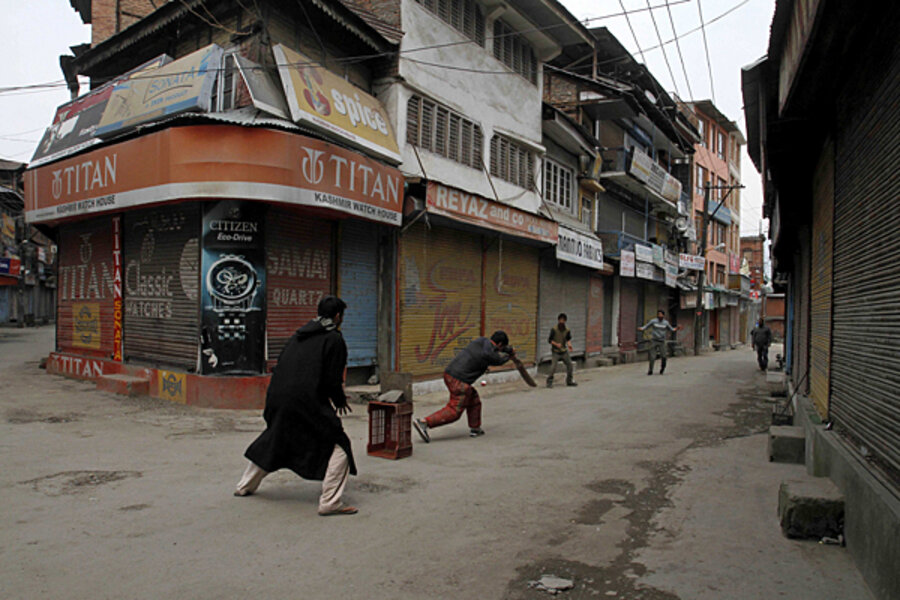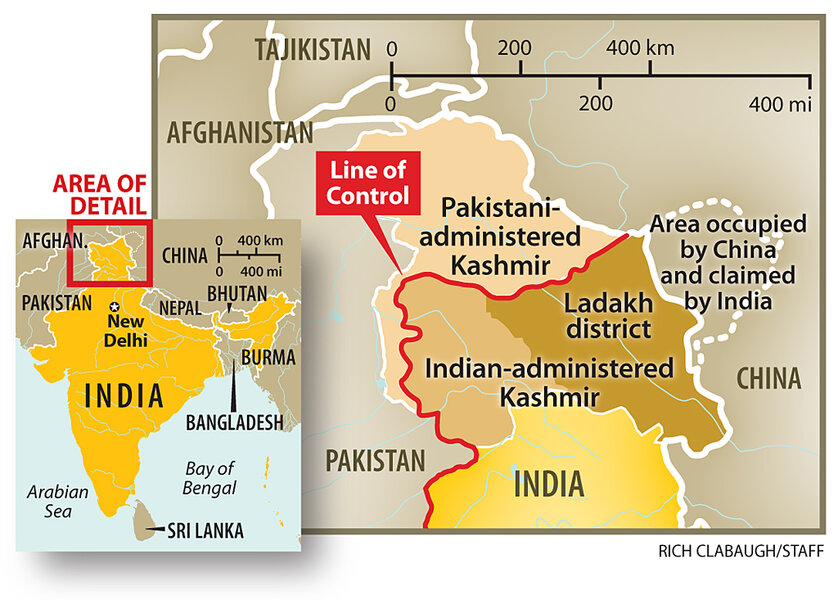Young Kashmiri activists yearn for an ‘Arab Spring’ - and more Western attention
Loading...
| Srinagar, India-controlled Kashmir
Ask Kashmiris about the uprisings in the Middle East and their frustration shows.
Rashid, a young computer professional, recalls how he joined last summer's street marches for freedom, survived India's police crackdown that killed 117 protesters, and watched as the events got only a sliver of the coverage now given to countries like Libya.
But as the winter snows recede from the circling Himalayan peaks, residents living among the barracks and barbed wire that attest to India's heavy presence here wonder if a touch of the Arab Spring might blossom in Kashmir. Such a development could attract the international attention that they argue is desperately needed for peace.
"In Tunisia and Egypt, behind the success of these revolutions is only media. We want international media to cover our issues because we know the results of peaceful protests in [Egypt's] Tahrir Square," says Rashid, who uses a false name out of fear of detention and torture.
What Kashmir's young independence activists most want the world to grasp is that the protracted fight for Kashmir has broken from its roots in a territorial tug of war between India and Pakistan. Instead, it has become an independence movement led by the two-thirds of Kashmiris who are under age 30 and fed up with living in a police state.
Particularly of interest to world powers, they say, should be their resolve to resist without guns.
But while US support for Arab uprisings is reinvigorating hopes among Kashmiris, whose persistence complicates US efforts to draw closer to India and win more cooperation from Pakistan, it is also sharpening longstanding disappointment.
The US role
Syed Ali Shah Geelani, the imposing octogenarian leader of Kashmir's separatist movement, minces no words, chiding the United States for what he sees as its shortcomings on Kashmir. For half a century, Mr. Geelani has been involved in the struggle, and remembers how the US sponsored the first United Nations resolution calling for Kashmiri self-determination. In recent years, however, Washington has courted New Delhi as a rising power – and dropped its public pressure, at least, over Kashmir. In March, Timothy Roemer, US ambassador to India, visited Kashmir but declined to meet separatist leaders.
"You have seen in Egypt only 17 days of strikes. And we are doing strikes since 1947 ... and you good people, pious people, very intelligent people, very moderate people, and very prosperous people, you have not taken notice," he says in an interview at his home, where some dozen Indian police keep him under house arrest.
Still, he takes a very long view of what he sees as the current, unpromising diplomatic calculus. "Superpowers are not forever superpowers," he reminds.
The US has played an active role in restarting talks between India and Pakistan that began March 28. And Geelani's younger counterpart among the separatist leadership, Mirwaiz Umar Farooq, sees more immediate signs of change. At conferences in the West since the Arab uprisings, he says, people approach him about Kashmir.
"In a situation like Egypt, eventually the international community had to accept the fact that the majority of people are saying something and they should be heard," says Mr. Farooq. "India might not feel the pressure right now, but I believe that the acceptability of [our] peaceful struggle is growing day by day."
Young Kashmiris, emboldened by their numbers, are impatient to be the generation to win azadi, or freedom, despite the fact that most India experts discount their prospects.
Over cups of noon chai, a green tea with salt, Rashid and several other young men describe how international pressure on India is their main hope, given state repression.
Social networking
Facebook and Twitter?Their uses as an organizing tool ended after Indian police arrested three young people for posting on Facebook last year. "There are only two ways to communicate: phone calls or SMS [text messages]. We have a ban on SMS. Phone calls are monitored, so how can we interact with each other?" says Rashid.
Nor does the movement have many leaders. Over the winter, police studied images of last summer's protests and detained more than 5,000 young men. Most have been released, with pressure on their parents to rein them in. Those remaining can face two-year detentions without trial under a law criticized in a new Amnesty International report.
"Hundreds ... are being held each year on spurious grounds, with many exposed to higher risk of torture," said Amnesty International's Sam Zarifi in a release. "[A]uthorities are using detentions as a revolving door to keep people … locked up."
Youths put their hope in international support
Blocked from activism, youths put their hope in international support. For this, they are willing to risk a meeting with foreign journalists, leading them through back alleys to evade security forces and police informers.
Rashid's friend Shabeer, a 20-year-old businessman, describes the day in 2010 when he became a stone thrower, as many young people did last summer. He was returning from the funeral of a boy killed by police.
Shabeer says security forces opened fire on the crowd without provocation. "We were scared but we were ready to die for the cause," he says. He picked up stones and returned volleys. "If that time I had a gun, I would fire back."
Indian officials say they are eager to avoid a repeat of the violence this summer, and tout measures they are taking to engage young people and keep them from taking to the streets. During the winter lull in protests, the police tried to set up alternative outlets for youths, offering sports as well as jobs in the force.
Mercy Corps, meanwhile, funded a conference in March that gave young Kashmiris a rare chance to meet and talk about ways forward. One day focused on cultural heritage, led by young people who have found a broader voice in art than stones. "I have this tool of metaphor I use and I can communicate without being sued or arrested," says Malik Sajad, a 23-year-old political cartoonist whose work is online at kashmirblackand white.com.
He is working on a graphic novel about young people who grew up amid Kashmir's recent decades of turmoil, told through the story of the hangul, an endangered deer. "The hangul don't understand these big [political] ideas," he says. "They are suffering, and that's why they react."






